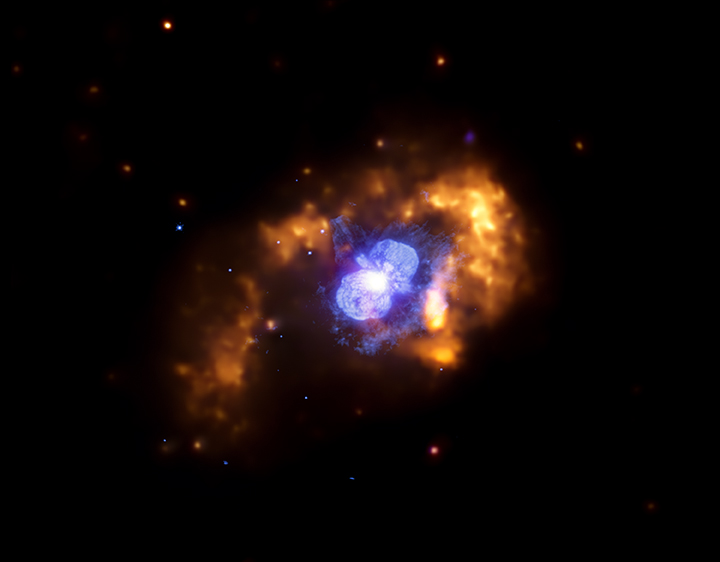I'm very sorry.
Everything else I said about it still applies though.
OK, less embarrassing, and more interesting stuff:
A quick video of Venus starting to align with the sun to produce the coming transit, as seen from the SOHO spacecraft [2]:
Video above: Venus approaching the Sun, as seen by SOHO. Video courtesy of NASA Goddard space centre.
What I really love about this: You can see Mercury as well, giving a nice sense of looking into a spinning inner solar system.
The sun itself is blanked out, as the usual purpose of the LASCO C3 coronograph, the instrument taking this picture, is to observe the Suns corona (outer atmosphere), which is much fainter than the solar surface. The instrument is so sensitive that both Mercury and Venus are bright enough to overpower the pixels on the coronographs detector - causing the huge death-ray-spikes of light on either side of them.
Image above: A stunning image of Venus as it approaches the transit, showing the ring of scattered sunlight from high altitude particles in its atmosphere. Image courtesy of Lorenzo Comolli, and spaceweather.com.
Remember in my last, erroneous, blog post I pointed out that the suns light refracts about Venus, producing a 'ring of fire' around it, even before it has fully entered the Suns disk?
No?
OK, I only mentioned it briefly. But it turns out that this is important, because it allows astronomers here on Earth to probe the venusian atmosphere [3]. And the Venusian atmosphere is a dozen mysteries, wrapped in a conundrum, and hidden beneath sulphuric acid clouds.....
Image left: A combined X-Ray and optical image of the Homunculus nebula, home to the Eta-Carinae double star. The X-ray segment was taken by the Chandra space telescope, the optical part by the Hubble Space Telescope [4].The outer horseshoe shaped cloud is about two light years across, only visible in x-rays, and is evidence of a massive stellar tantrum about a thousand years ago. Image courtesy of NASA/JPL
ESA's Herschel space telescope [5] has produced another stunning picture, this time of the Carina nebula, which is home to several open clusters of young stars, star spawning regions of filaments and Bok globules [6], and the monstrous Eta Carinae double star. One of the stars in the system is thought to be a wolf rayet star [7], the other a huge ultra heavy luminous blue variable [8], weighing in at over a hundred times our suns mass. The pair are so unstable that they blast the bizarre Homunculus Nebula into the space around them.
Eta Carina has, at times, been almost as bright as Sirius [9] (itself a fascinating double star). Considering that Sirius is about eight and a half light-years away, and Eta Carinae is over seven thousand, the unstable double star must have been putting out a titanic amount of power at the time. And it spat our two lobes of super hot material, each weighing as much as our Sun or more, travelling at seven hundred km per second, making the Homunculus Nebula [10] we see today.
As Dr. Kris Davidson, from the University of Minnesota puts it: "If Eta Carina becomes a Supernova next Thursday, we shouldn't be surprised."

Image above: The massive Carina nebula, home to almost every kind of stellar beast you could imagine. It's even bigger and brighter than the Orion Nebula, but less well known because it's only visible in the southern hemisphere. Which seems a bit unfair to me, but never mind. We can see the voids carved into the nebula by the stellar winds of new born stars. The is picture was taken in the infra red by the ESA Herschel spacecraft. Image courtesy of ESA.
We get three fairly close NEO flybys in June: 2002 AC [11] and 1999 BJ8 [12] on June 16th, both passing by 60 to 70 times as far away as the Moon, both just over kilometre big. The third, on June 21st, is 2005 GO21 [13], which will be observed [14] by the Goldstone [15] and Arecibo [16] deep space radars. Arecibo expect to resolve the object to within a thousand pixels, and get a measurement of it's rate of rotation.
Finally: This week sees the Scorpid and Aretid meteor showers peak, with expected fall rates of twenty per hour and thirty per hour respectively. Watch out for the Scorpids Tuesday night, and the Aretids just after sundown Thursday.
The weather here in Manchester doesn't look promising for tomorrow. Still I'm going to go to bed with at least the hope that the sun might break through before I head for work. For long enough, perhaps, for me to use my telescope as a projector and catch a tiny piece of this never to be seen again (unless I wind up as a Futurama style head in a jar) event.
Tom Hanks. In a jar. Image courtesy of Matt Groening.
Cup of tea and then bed methinks.....
List of links:
[1]http://sunearthday.nasa.gov/2012/transit/viewing_locations.php
[2]http://sohowww.nascom.nasa.gov/
[3]http://science.nasa.gov/science-news/science-at-nasa/2012/04jun_arcofvenus/
[4]http://hubblesite.org/
[5]http://herschel.esac.esa.int/
[6]http://www.universetoday.com/24499/journey-inside-a-bok-globule/
[7]http://imagine.gsfc.nasa.gov/docs/ask_astro/answers/980603a.html
[8]https://www.cfa.harvard.edu/~pberlind/atlas/htmls/lbvstars.html
[9]http://en.wikipedia.org/wiki/Sirius
[10]http://en.wikipedia.org/wiki/Homunculus_Nebula
[11]http://ssd.jpl.nasa.gov/sbdb.cgi?sstr=2002 AC&orb=1
[12]http://ssd.jpl.nasa.gov/sbdb.cgi?sstr=1999 BJ8&orb=1
[13]http://ssd.jpl.nasa.gov/sbdb.cgi?sstr=2005 GO21&orb=1
[14]http://ssd.jpl.nasa.gov/sbdb.cgi?sstr=2005 GO21&orb=1
[15]http://deepspace.jpl.nasa.gov/technology/TMOT_News/FEB97/gldstone.html
[16]http://www.naic.edu/



No comments:
Post a Comment